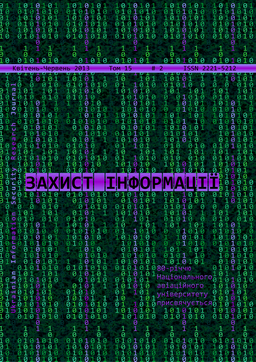Steganalysis algorithm for images that have been lossy compressed
DOI:
https://doi.org/10.18372/2410-7840.15.4776Keywords:
Steganography, steganalysis, close-color pairs, unique colors, information hidingAbstract
Easy to use, and also a lot of software tools both paid and free, freely distributed on network, made steganography very popular tool by which you can provide a simple way of diversion of valuable information and uncontrolled exchange of information for illegal purposes. These circumstances make greater efforts to develop algorithms for steganalysis. One type of such algorithms are algorithms that are based on the analysis of color pairs of digital images. Most of the existing similar means focused on working with images that are stored in a lossless format, which significantly narrows the scope of their application. Taking this into account in the steganalysis algorithm has been proposed for determining presence a secret message embedded into digital image which has been lossy compressed, using method of least significant bit. The results showed that the principle of the analysis color pairs can be successfully applied for steganalysis digital image is subjected to a lossy compression.
References
Бобок И.И. Стеганоанализ, как частный случай анализа информационной системы / Бобок И.И., Кобозева А.А. // Сучасна спеціальна техніка. – 2011. – №1. – С. 25-36.
Бобок И.И. Стеганоаналитический алгоритм для основного сообщения, хранимого в форматах с потерями / И.И.Бобок // Вісник національного технічного ун-ту «ХПІ». – 2012. – № 29. – С.41-49.
Гонсалес Р., Вудс Р. Цифровая обработка изображений.- М.: Техносфера, 2005.– 1072 с.
Грибунин В.Г. Цифровая стеганография. / Грибунин В.Г., Оков И.Н., Туринцев И.В. – М.: Солон-Пресс, 2002. – 272 с.
Конахович Г.Ф., Пузыренко А.Ю. Компьютерная стеганография. Теория и практика. – МК-Пресс, 2006.
Рудницкий В.Н. Стеганоаналитический алгоритм, основанный на анализе пар цветов / Рудницкий В.Н., Узун И.А.// Інформатика та математичні методи в моделюванні. – 2012. – Т.2, №3. – С. 210-220.
Швидченко И.В. Анализ криптостеганографических алгоритмов // Проблемы управления и информатики, 2007. – № 4. – С. 149-155.
Fridrich J., Du R., Long M. Steganalysis of LSB encoding in Color images, IEEE International Conference on Multimedia and Expo, vol.3, 2000, pp. 1279-1282.
Geetha S., Silva S.Sivatha Sindhu, Kamaraj N. Close color pair signature ensemble adaptive threshold based steganalysis for LSB embedding in digital images. Transactions on Data Privacy, 1(2009) 140-161.
Gul G., Kurugollu F. SVD-Based Universal Spatial Domain Image Steganalysis / IEEE Transactions on Information Forensics and Security. – 2010. – Vol. 5, No. 2. – P. 349-353.
Johnson Neil F., Jajodia Sushil. Steganography: Seeing the Unseen. IEEE Computer, February 1998, pp. 26-34.
Kelley J. Terrorist instructions hidden online, USA Today – 2001.
Mitra S., T.Roy, D.Mazumadar, A.Saha. Steganalysis of LSB encoding in uncompressed images by close color pair analysys. CDAC, Kolkata
Seymer P., Dimitoglou G., Performance Optimization of Close-Color Pair Steganalysis, Proceedings of the 2007 International Conference on Security & Management, pp. 123-127, Las Vegas, USA. 2007.
Stuart Fox. How Russian spies hid secret codes in online photos. Tech News, the Christian Science Monitor. 2010.
Bobok I.I., Kobozeva A.A. Steganalysis as a special case of the analysis of the information system, Modern special-purpose machinery, 2011, No 1, pp. 25-36.
Bobok I.I. Steganalysis algorithm for the basic message stored in the lossy formats, Visnyk of national technical university «HPI», 2012, No 29, pp. 41-49.
Gonsales R., Vuds R.. Digital image processing, М.: Techno sphere, 2005, 1072 p.
Gribunin V.G., Okov I.N., Turintsev I.V. Digital steganography, M.: Solon-Press, 2002, 272 p.
Konahovich G.F., Puzirenko A.U. Computer steganography. Theory and Practice, MK-Press, 2006.
Rudnitskiy V.N., Uzun I.A.Steganalysis algorithm based on the analysis of color pairs, Computer and mathematical methods in modeling, 2012, Т.2, No 3, pp. 210-220.
Shvidchenko I.V. Analysis of the crypto-steganography algorithms, Problems of management and informatics, 2007, No 4, pp. 149-155.
Fridrich J., Du R., Long M. Steganalysis of LSB encoding in Color images, IEEE International Conference on Multimedia and Expo, vol.3, 2000, pp. 1279-1282.
Geetha S., Silva S.Sivatha Sindhu, Kamaraj N. Close color pair signature ensemble adaptive threshold based steganalysis for LSB embedding in digital images. Transactions on Data Privacy, 1(2009) 140-161.
Gul G., Kurugollu F. SVD-Based Universal Spatial Domain Image Steganalysis / IEEE Transactions on Information Forensics and Security, 2010, Vol. 5, No. 2, pp. 349-353.
Johnson Neil F., Jajodia Sushil. Steganography: Seeing the Unseen. IEEE Computer, February 1998, pp.26-34.
Kelley J. Terrorist instructions hidden online, USA Today, 2001.
Mitra S., T.Roy, D.Mazumadar, A.Saha. Steganalysis of LSB encoding in uncompressed images by close color pair analysis. CDAC, Kolkata
Seymer P., Dimitoglou G., Performance Optimization of Close-Color Pair Steganalysis, Proceedings of the 2007 International Conference on Security & Management, pp. 123-127, Las Vegas, USA. 2007.
Stuart Fox. How Russian spies hid secret codes in online photos. Tech News, the Christian Science Monitor. 2010.
Downloads
Published
Issue
Section
License
Authors who publish with this journal agree to the following terms:- Authors retain copyright and grant the journal right of first publication with the work simultaneously licensed under a Creative Commons Attribution License that allows others to share the work with an acknowledgement of the work's authorship and initial publication in this journal.
- Authors are able to enter into separate, additional contractual arrangements for the non-exclusive distribution of the journal's published version of the work (e.g., post it to an institutional repository or publish it in a book), with an acknowledgement of its initial publication in this journal.
- Authors are permitted and encouraged to post their work online (e.g., in institutional repositories or on their website) prior to and during the submission process, as it can lead to productive exchanges, as well as earlier and greater citation of published work (See The Effect of Open Access).

